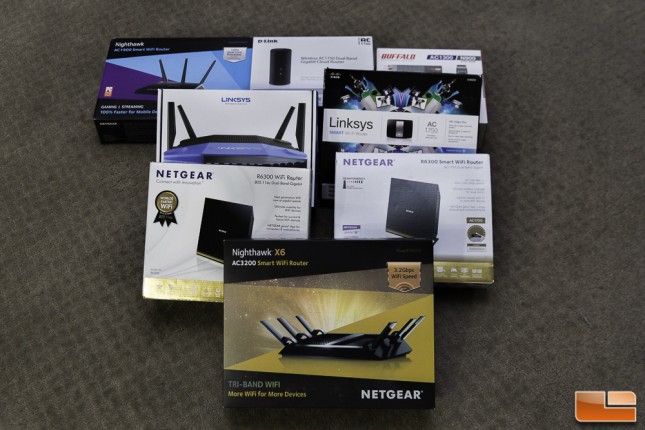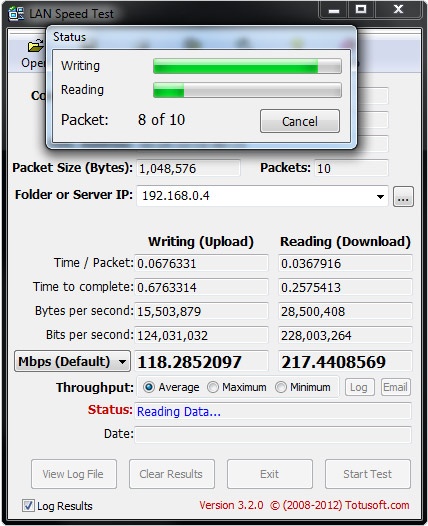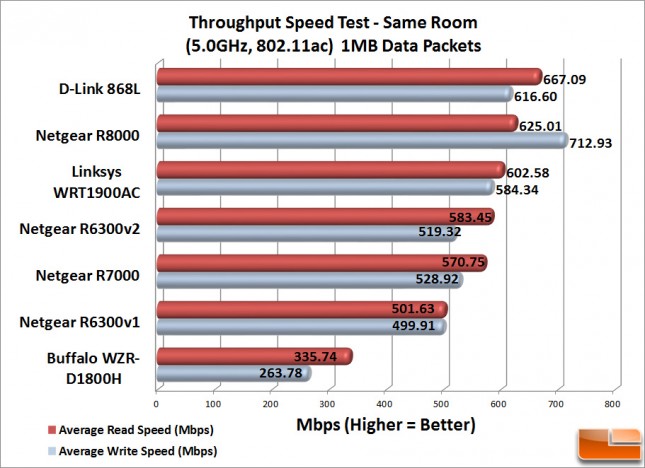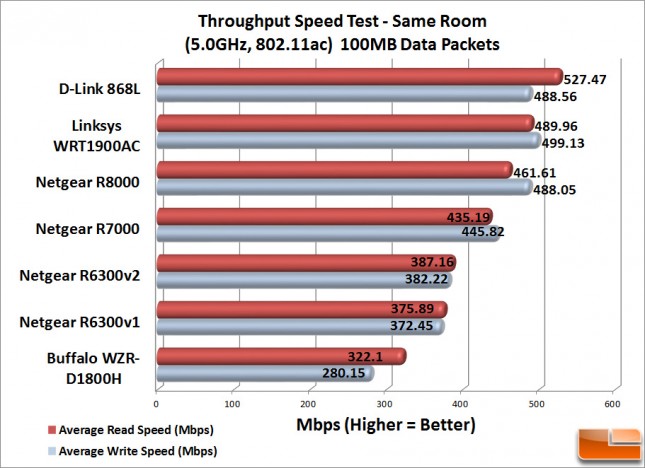Netgear R8000 Nighthawk X6 AC 3200 Tri-Band WiFi Router Review
Netgear R8000: Speed Tests – Same Room
 We were really interested to see the real-world wireless speed performance of the Netgear X6 Nighthawk R8000 so instead of taking the same approach as we have in previous router reviews, we changed some things up starting with the equipment that we used. We connected the Netgear R8000 to our desktop PC running Windows 8.1 Pro 64-bit and configured the router using Automatic settings for a 5Ghz bandwidth. We then took our laptop to use as a client and connected it to a Netgear R7000 Wireless Router. We put the router into Bridge Mode and paired it with our suite of 802.11ac routers, including the Netgear X6 R8000. The R7000 is one of the latest wireless-AC routers on the market and should work very well as a bridge. We took our Laptop/R7000 Bridge and didnt tell the client anything more than the SSID name for each router tested and let it automatically choose the cleanest channel to connect to. For the fastest possible data throughput, the routers were set to Unsecure Mode and with WMM turned ON. After connecting, we ran the application LAN Speed Test (LST) version 3.4.0 to measure file transfer and network speeds. LST builds a file in memory and then transfers the packet without the effects of windows file caching. It then reports the time and calculates the network speed.
We were really interested to see the real-world wireless speed performance of the Netgear X6 Nighthawk R8000 so instead of taking the same approach as we have in previous router reviews, we changed some things up starting with the equipment that we used. We connected the Netgear R8000 to our desktop PC running Windows 8.1 Pro 64-bit and configured the router using Automatic settings for a 5Ghz bandwidth. We then took our laptop to use as a client and connected it to a Netgear R7000 Wireless Router. We put the router into Bridge Mode and paired it with our suite of 802.11ac routers, including the Netgear X6 R8000. The R7000 is one of the latest wireless-AC routers on the market and should work very well as a bridge. We took our Laptop/R7000 Bridge and didnt tell the client anything more than the SSID name for each router tested and let it automatically choose the cleanest channel to connect to. For the fastest possible data throughput, the routers were set to Unsecure Mode and with WMM turned ON. After connecting, we ran the application LAN Speed Test (LST) version 3.4.0 to measure file transfer and network speeds. LST builds a file in memory and then transfers the packet without the effects of windows file caching. It then reports the time and calculates the network speed.  We repeated the test 2 more times rotating the router 90 degrees after each test to make sure that the routers speed was affected adversely by its orientation. We took speed measurements at three different locations of the Legit Bunker: In the Same Room at exactly 5.5 feet away from the test router; in a 2nd Room about 20 feet away from the router through a wooden door; and in a Far Room, one level below (wood framed floor) where the client router/bridge sat. Doing this should really give us a nice taste of how our routers perform in the real-world.
We repeated the test 2 more times rotating the router 90 degrees after each test to make sure that the routers speed was affected adversely by its orientation. We took speed measurements at three different locations of the Legit Bunker: In the Same Room at exactly 5.5 feet away from the test router; in a 2nd Room about 20 feet away from the router through a wooden door; and in a Far Room, one level below (wood framed floor) where the client router/bridge sat. Doing this should really give us a nice taste of how our routers perform in the real-world.  Benchmark Results: Our first test showed what we thought was a shocking resultthat is one of the oldest routers in our round up, the $130 D-Link 868L comes out on top when it comes to Average Read Speeds. Upon further review, we have to take these results with a bit of caution since all the router manufactures recommend that you go out at least 8-10 feet to get the optimal performance from the wireless signals. The brand new Netgear R8000 and Linksys WRT1900AC seemed to work very well with the Netgear R7000 bridge producing average read/write speeds well over 600 Mbps. One other thing to note here is that we ran all of our 1MB tests with 240 packets to test successively (one after the other) to effectively get a good measurement of speed.
Benchmark Results: Our first test showed what we thought was a shocking resultthat is one of the oldest routers in our round up, the $130 D-Link 868L comes out on top when it comes to Average Read Speeds. Upon further review, we have to take these results with a bit of caution since all the router manufactures recommend that you go out at least 8-10 feet to get the optimal performance from the wireless signals. The brand new Netgear R8000 and Linksys WRT1900AC seemed to work very well with the Netgear R7000 bridge producing average read/write speeds well over 600 Mbps. One other thing to note here is that we ran all of our 1MB tests with 240 packets to test successively (one after the other) to effectively get a good measurement of speed.  Benchmark Results: In this test we looked at test packets that were 100MB in size. We find this is a good measurement for how our routers will do when trying to move larger data files like multimedia over wireless. Again, we see the D-Link 868L router that was released in early 2013 rising to the top with Average Read Speeds of over 527 Mbps. The flagship Belkin/Linksys WRT1900AC is right at 500 Mbps transfer speed (well above what we tested earlier this year with the WRT1900AC). The Netgear is a tick behind both the D-Link and Linksys but only by a hair. We would say that all of these next-gen AC routers are very close in their performance for this Same Room test. We really believe that there is more in the tank for the Netgear and Linksys routers, but because and we might be too close to really see their potential.
Benchmark Results: In this test we looked at test packets that were 100MB in size. We find this is a good measurement for how our routers will do when trying to move larger data files like multimedia over wireless. Again, we see the D-Link 868L router that was released in early 2013 rising to the top with Average Read Speeds of over 527 Mbps. The flagship Belkin/Linksys WRT1900AC is right at 500 Mbps transfer speed (well above what we tested earlier this year with the WRT1900AC). The Netgear is a tick behind both the D-Link and Linksys but only by a hair. We would say that all of these next-gen AC routers are very close in their performance for this Same Room test. We really believe that there is more in the tank for the Netgear and Linksys routers, but because and we might be too close to really see their potential.
